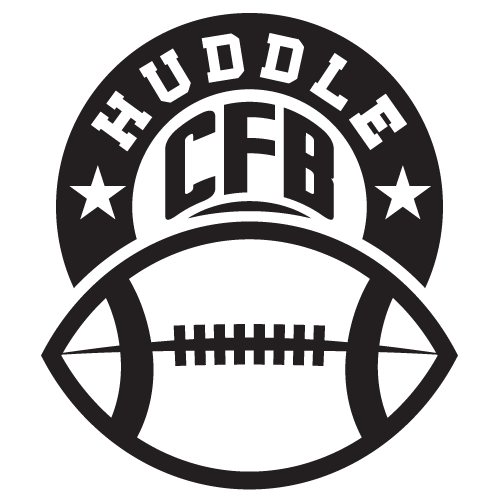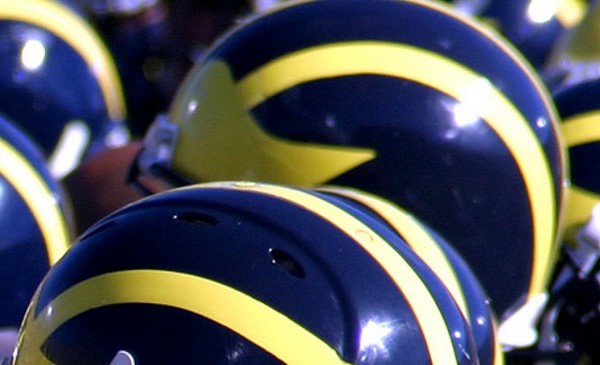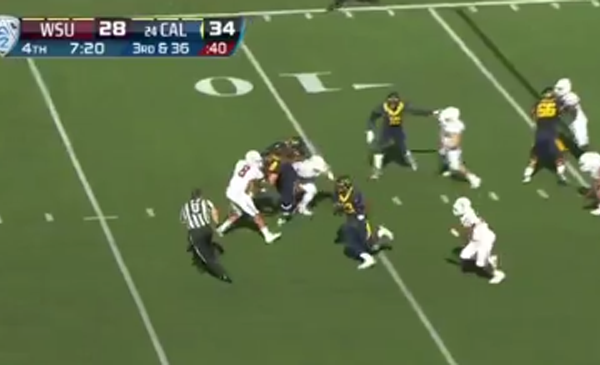In the ol’ Book of Football Cliches is an entry dedicated to “Nothing in the playbook for third-and-whatever.” The actual distance from which this cliche can be accurately invoked is ambiguous, but is essentially anything behind the original line of scrimmage.
Or, if you’re Jesse Palmer, it’s third-and-California. (I kid because I love, Jess. Let’s do sushi at Urasawa next time you’re in L.A.)
Cal facing third-and-36 last Saturday against Washington State was the textbook example of a team having nothing in the playbook for converting a first down. Head coach Sonny Dykes admits as much.
“We were probably just trying to get some yards, give us enough room to punt the ball,” he said.
Cal rallied from a two-touchdown deficit in the first half, taking its first lead, 34-28, two possessions earlier. Few know how dangerous and how quickly a Mike Leach-coached offense can score better than Dykes, a colleague of the Washington State head coach for six years at Texas Tech.
Giving the Cougars the ball back with favorable field position was clearly not an option. So, despite boasting one of the nation’s most prolific passing offenses, quarterbacked by talented junior Jared Goff, going deep on a pass play was not in the cards.
A little over seven minutes remained when Goff took the third-and-36 snap. A long run — say 10 yards — would keep the clock ticking for when the punting unit came onto the field. By the time Washington State took over possession, the Cougars would have maybe six minutes left; enough to put the pressure on them to score on that particular drive, but not so little as to doom Cal should its defense give up a touchdown.
Still, there was that glimmer of hope that just maybe, something in the playbook could turn third-and-36 into a first down.
“Any time you call a play, you expect it to work,” Dykes explained.
Still…from that distance? The Golden Bears might as well have lined up in Oakland and they’re chances of conversion were probably about equal. At least then, offensive coordinator Tony Franklin could have called a hand-off to the BART.
Running back Vic Enwere isn’t the BART, but the 6-foot-1, 230-pound power-back sorta looks like a train when he gets rolling. And, unlike the BART, Cal need not worry about a possible delay.
Among the many AMAZING moments from #CALvsWSU, Vic Enwere rumbling on 3rd and 36 has to be our #12Best Moment. http://t.co/njUOIkvetv
— Pac-12 Networks (@Pac12Networks) October 3, 2015
“It was one of those calls that probably looked better than it really was,” Dykes said.
Indeed, the draw is such a simple call. In this particular situation, however, it was the right call, albeit one made to look all the more impressive by stellar execution.
“There’s ways to block all the different looks you’re going to get,” Dykes explained. “We ran power there where we pulled the guard around and blocked down. As I said -” Dykes previously mentioned Washington State was in a prevent defense — “they were dropping [eight players back], which was probably the smart thing to do becuase they were assuming we were going to throw the ball.”
Borrowing from the Book of Cliches, looks like Washington State was in the prevent, alright: prevent victory! Right? *clears throat* Moving on.
“Vic got to the second level, and Trevor Davis did a nice job of blocking out of the wide receiver spot,” Dykes continued. “We just kind of got the ball into a soft part of their defense. Vic broke a couple of tackles. Their safety missed a tackle…[and Enwere] used a stiff-arm.”
The moral of Cal’s third-and-36 conversion isn’t so much about having something in the playbook for such a situation. As Dykes said, the call itself looked better as a result of Enwere’s run and the outstanding blocking Cal had all over the field.
This particular play also wasn’t necessarily a back-breaker for Washington State. The Cougars actually forced a turnover on downs by tackling Enwere in the backfield on a fourth-and-4 swing pass.
But that stop came a full three minutes later on the game clock, setting up Washington State at its own 38 — roughly where it would have taken possession had Cal failed to convert on third-and-36 — with much more urgency than had it taken possession earlier.
The result of the ensuing drive was a game-deciding interception.
Enwere’s conversion may not have ended the game, but it played a critical role. It also reinforced the significance of each snap, regardless of circumstance.
“Every play’s important,” Dykes said. “You don’t know when this particular play is going to be the difference in a ball game. Sometimes you look at that and say, ‘well, it’s a throwaway down. They’re just going to run the ball and try to punt.’ But our guys kept playing hard, to their credit, and got a big first down.”



